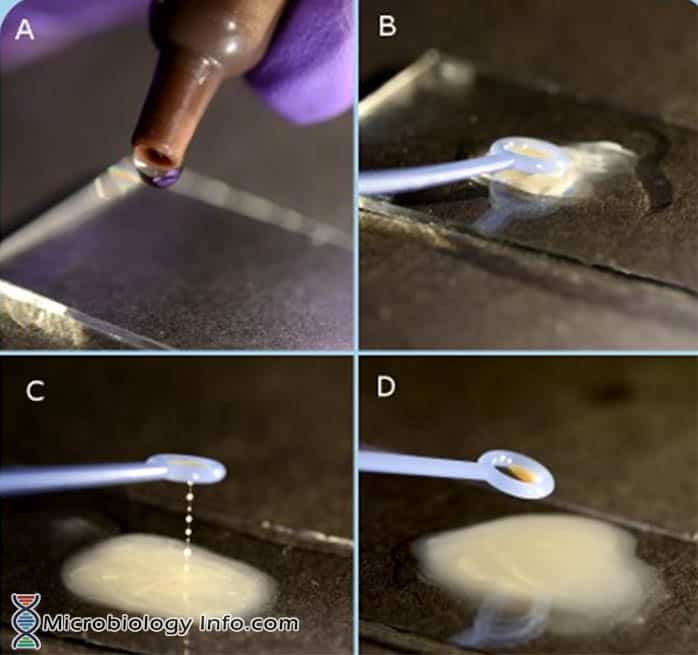The KOH String Test relies on the differential resistance to 3% potassium hydroxide between gram positive and negative cells, where a portion of a colony is mixed with a small volume of 3% KOH. If the cells lyses, the liberated cellular DNA makes the mixture viscous or “stringy.” The positive string test indicates a gram negative organism. Hence the alternative name for the test is “String Test”.
The potassium hydroxide test may thus aid in differentiation between Gram positive and Gram negative organisms and is a useful complement to the Gram stain and the antibiotic disc test.
Objective
To differentiate between Gram negative and Gram positive organisms
Principle
Like the Gram stain reaction, the KOH test is based on differences in the chemistry of the bacterial cell wall. In the presence of potassium hydroxide, Gram negative cell walls are broken down. KOH easily dissolves the thin layer of peptidoglycan of the cell walls of gram negative bacteria. Disintergration of gram negative cell wall lyses the cell and release its contents, including the DNA. As a result, a viscid chromosomal material is released which causes the bacterial suspension to become thick and stringy. The viscous and the solution sticks to the loop when touched.
On the other hand, Gram positive bacteria are not affected by KOH, because they have thicker peptidoglycan layer in the cell wall. Thus, the cells are not lysed, the DNA is not released and no viscosity is observed.
Method
- Place one drop of 3% potassium hydroxide solution on a clean microscope slide.
- Emulsify a few colonies of the suspect organism to the drop of potassium hydroxide to make a dense suspension.
- Stir continuously for 60 sec and then gently pull the loop away from the suspension.
- Observe for any changes.
Expected Results
- Positive: Organisms become thick, stringy and form long strands within the first 30sec. This is seen in Gram negative bacteria.
- Negative: Organisms leave the suspension unaltered or absence of stringing. This is seen in Gram positive bacteria.
Uses
- In laboratories where large numbers of cultures have to be processed, the above test may be used in addition to Gram stain for preliminary differentiation.
- It is a useful complement to the Gram stain and the antibiotic disc test.
Limitations
- Although useful, a negative test does not prove conclusively that an organism is Gram positive.
- Older cultures (>48hr) may turn positive after 30sec of mixing the bacteria in the KOH solution giving unreliable results. This is common with certain species such as Achromobacter species, Brucella melitensis, Pseudomonas paucimobilis, Moraxella species, etc.
- False positive results can occur from too heavy an inoculum (the solution will appear to gel, but not string), or inoculation with mucoid colonies.
- False negative results can also occur in the test by using too little inoculums or too much KOH (DNA-induced viscosity not noticeable).
References
- https://assets.publishing.service.gov.uk/government/uploads/system/uploads/attachment_data/file/757572/TP_30i3.pdf
- Suslow, T. V., M. N Schroth, and M. Isaka. 1982. Application of a rapid method for Gram differentiation of plant pathogenic and saprophytic bacteria without staining. Phytopathology 72: 917 918.
- https://wiki.bugwood.org/KOH_test
- https://www.vetbact.org/index.php?displayextinfo=117
- http://eqap.eqap.ir/Resources/PDF/KOH%20STRING%20TEST.pdf
- https://www.apsnet.org/edcenter/K12/TeachersGuide/DNA_Easy/Pages/Background.aspx
Similar Posts:
- Cryptococcus Neoformans – Habitat, Morphology, Epidemiology, Virulence Factors, Treatment + More
- Widal Test- Introduction, Principle, Procedure, Interpretation and Limitation
- Rapid Plasma Reagin (RPR) Test for the diagnosis of Syphilis
- Oxidase Test- Principle, Uses, Procedure, Types, Result Interpretation, Examples and Limitations


what test can I do to test the percentage of potassium hydroxide in the solution?